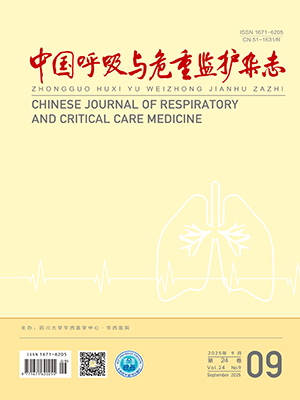| 1. |
国家卫生健康委办公厅 国家中医药管理局办公室《新型冠状病毒感染的肺炎诊疗方案 (试行第五版)》.http://www.nhc.gov.cn/yzygj/s7653p/202002/3b09b894ac9b4204a79db5b8912d4440.shtmll.
|
| 2. |
Lapinsky SE, Hawryluck L. ICU management of severe acute respiratory syndrome. Intensive Care Med, 2003, 29(6): 870-875.
|
| 3. |
Caputo KM, Byrick R, Chapman MG, et al. Intubation of SARS patients: infection and perspectives of healthcare workers. Can J Anaesth, 2006, 53(2): 122-129.
|
| 4. |
AARC Evidence-Based Clinical Practice Guidelines. Care of the ventilator circuit and its relation to ventilator-associated pneumonia. Respir Care, 2003, 48: 869-879.
|
| 5. |
Han JN, Liu YP, Ma S, et al. Effects of decreasing the frequency of ventilator circuit changes to every 7 days on the rate of ventilator-associated pneumonia in a Beijing hospital. Respir Care, 2001, 46: 891-896.
|
| 6. |
Kollef MH. The prevention of ventilator-associated pneumonia. N Engl J Med, 1999, 340: 627-634.
|
| 7. |
Cook D, De Jonghe B, Brochard L, et al. The influence of airway management on ventilation associated pneumonia: Evidence from randomized trials. JAMA, 1998, 279: 781-787.
|
| 8. |
Weber DJ, Rutala WA. Nosocomial infections associated with respiratory therapy. In: Mayhall CG. Hospital Epidemiology and Infection Control. 3rd edition. Baltimore: Williams & Wilkins, 1996, 748-758.
|
| 9. |
Memish ZA, Oni GA, Djazmati W, et al. A randomized clinical trial to compare the effects of a heat and moisture exchanger with a heated humidifying system on the occurrence rate of ventilator-associated pneumonia. Am J infect Control, 2001, 29: 301-305.
|
| 10. |
Daumal F, Colpart E, Manoury B, et al. Changing heat and moisture exchangers every 48 hours does not increase the incidence of nosocomial pneumonia. Infect Control Hosp Epidemiol, 1999, 20: 347-349.
|
| 11. |
Davis K Jr, Evans SL, Campbell RS, et al. Prolonged use of heat and moisture exchangers does not affect device efficiency or frequency rate of nosocomial pneumonia. Crit Care Med, 2000, 28: 1412-1418.
|
| 12. |
Klompas M, Branson R, Eichenwald EC, et al. Strategies to prevent ventilator-associated pneumonia in acute care hospitals: 2014 update. Infect Control Hosp Epidemiol, 2014, 35(8): 915-936.
|
| 13. |
Johnson KL, Kearney PA, Johnson SB, et al. Closed versus open endotracheal suctioning: costs and physiologic consequences. Crit Care Med, 1994, 22: 200-203.
|
| 14. |
Deppe SA, Kelly JW, Thoi LL, et al. Incidence of colonization, nosocomial pneumonia, and mortality in critically ill patients using a Trach Care closed-suction system versus an open-suction system: prospective, randomised study. Crit Care Med, 1990, 18: 1389-1393.
|
| 15. |
Johnson KL, Kearney PA, Johnson SB, et al. Closed versus open endotracheal suctioning: costs and physiologic consequences. Crit Care Med, 1994, 22: 200-203.
|
| 16. |
Combes P, Fauvage B, Oleyer C. Nosocomial pneumonia in mechanically ventilated patients, a prospective randomized evaluation of the Stercath closed suctioning system. Intensive Care Med, 2000, 26: 878-882.
|
| 17. |
Kollef MH, Prentice D, Shapiro SD, et al. Mechanical ventilation with or without daily changes of in-line suction catheters. Am J Respir Crit Care Med, 1997, 156: 466-472.
|
| 18. |
Harris AD, Samore MH, Nafziger R, et al. A survey on handwashing practices and opinions of healthcare workers. J Hosp Infect, 2000, 45: 318-321.
|
| 19. |
Pittet D, Mourouga P, Pernerger TV. Compliance with handwashing in a teaching hospital. Infection control program. Ann Intern Med, 1999, 130: 126-130.
|
| 20. |
Trick WE, Vernon MO, Hayes RA, et al. Impact of ring wearing on hand contamination and comparison of hand hygiene agents in a hospital. Clin Infect Dis, 2003, 36: 1383-1390.
|
| 21. |
World Health Organization. Infection Prevention and Control of Epidemic-and Pandemic-Prone Acute Respiratory Infections in Health Care[D]. 2014.
|
| 22. |
李国平, 卢平, 杜英荣, 等. 关于用于 SARS 病人呼吸机消毒问题的探讨. 医疗装备, 2003, 16(7): 14-15.
|
| 23. |
重症监护病房医院感染预防与控制规范. 中国感染控制杂志,2017, 16(2): 191-194.
|
| 24. |
陈学斌, 高敏, 安峥, 等. 呼吸机外表面消毒模式与院内感染的相关性分析. 中国医学装备, 2016, 13(7): 128-132.
|




